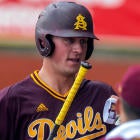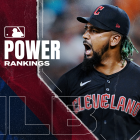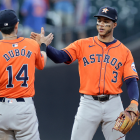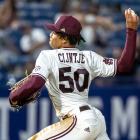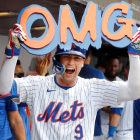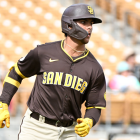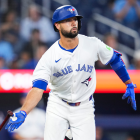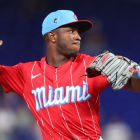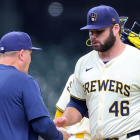Last week, it was reported Major League Baseball's 2020 draft would begin June 10, and that it would last just five rounds. While that's a departure from the norm (and not in a good way), we here at CBS Sports will be providing coverage up through the draft.
That process begins today, with a ranking of the top 25 position players in the class. On Wednesday, we'll rank the top 25 pitchers; on Friday, the top 50 prospects in this class.
Before we get to the rankings, we're legally obligated to offer a few caveats: 1) these were formed through a combination of insight gleaned from scouts and executives, as well our own analysis of the players; and 2) these are not supposed to align exactly with the actual draft order; their expected draft range was a consideration, however, along with their talent level and overall potential.
With that in mind, let's rank some position prospects.
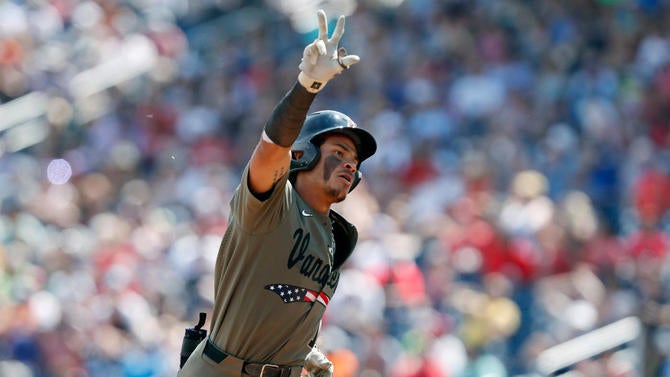
1. Austin Martin, CF/INF, Vanderbilt
Martin, a top-of-the-order hitter and versatile defender, might be the most intriguing player in the class. He has an impressive feel for contact and for the strike zone, finishing his Commodores career with a .368 batting average and more walks than strikeouts. (He was the toughest batter to strike out in the power conferences.) Though he homered just 14 times, his exit velocities suggest there's plus power potential under the surface, something he could achieve thanks to his offensive aptitude and a swing that already features loft. In short, Martin fits the profile of others who have added power to their games in recent years. He's also a skilled baserunner with good speed and smarts. Generally, having an undefined position is a negative. In Martin's case, it could turn out to be a positive. He was primarily a third baseman before this season, when he slid to center field to better leverage his wheels. A creative team could maximize his value by having him split time between the infield and the outfield, a la Whit Merrifield and Scott Kingery, among others.
2. Spencer Torkelson, 1B, Arizona State
You'd think Torkelson was a Joe Hill creation given the fear he invokes in opposing pitchers. He walked in 31 of his 82 plate appearances during the abbreviated NCAA season, but he still managed to improve his career homer count to 54 in 498 at-bats. Torkelson has the requisite eye, strength, and barrel control to profile as a quick-moving thumper. The biggest knock on him is that he's only a right-handed first baseman, and those seldom make for satisfying early selections -- it's basically a sample of the ballad of Andrew Vaughn, the third pick in last year's draft. Don't be surprised when Torkelson ends up going higher than Vaughn, perhaps even first.
3. Zac Veen, OF, Spruce Creek (HS)
With due respect to the fine people at the University of Florida, there's little chance Veen will be crossing paths with the Tom Petty tree anytime soon. Instead, he's likely to be popped early enough to justify beginning his pro career. Veen has the tall, lean, broad-shouldered frame that bodes well for him adding muscle over the coming years (and for drawing comparisons to Jayson Werth). He also has more than enough bat speed and discretion at the plate to project as a potential middle-of-the-order hitter. Veen's odds of remaining in the middle of the outfield are considerably more remote, but his strong arm should make him a fit in right field.
4. Nick Gonzales, 2B, New Mexico State
If one of the top-ranked hitters is going to slide on draft day, then it's probably going to be Gonzales. Despite incinerating the Western Athletic Conference (.448/.610/1.155 slash line with 12 home runs and 11 more walks than strikeouts in 16 games) and last summer's Cape Cod League (.351/.451/.630), there are nagging concerns about his upside. His exit velocities were more pedestrian than one might suspect, leading some evaluators to believe his power potential (and the validity of comparisons to Milwaukee Brewers second baseman Keston Hiura) is overstated. A data-driven team might find it hard to justify popping Gonzales so early, lest they end up with a singles-hitting second baseman who isn't a threat to run or win a Gold Glove.
5. Austin Hendrick, OF, West Allegheny (HS)
The most notable baseball alum from West Allegheny High School is Scott Patterson, who played Luke on Gilmore Girls. Hendrick could usurp Patterson if he someday lands the role of cleanup hitter. His explosive swing lends itself to an approach that sees him trade contact for power. Hendrick scorched good competition last summer, posting absurd exit velocities along the way, and that performance ought to protect him against the typical cold-weather state bias. Not every team has the stomach for his swing-and-miss tendencies, and it's easy to envision him becoming a left-handed Clint Frazier, but that isn't the worst outcome by any means.
6. Garrett Mitchell, OF, UCLA
Mitchell is one of the fastest runners in the class, and he should have no problem remaining in center for the long haul. (He played right in 2019 out of deference to former first-round pick Matt McLain, who moved to shortstop this season.) The other elements of his game are less certain. Mitchell has the kind of athleticism and angular frame that scouts dream about, and he puts on a better BP than his in-game power numbers indicate (his .151 career ISO is propped up by 15 triples, as compared to six home runs). He's already reconfigured his swing once since high school, and a team hoping to help him unlock his star potential could task him with trying it again. Mitchell, a Type 1 diabetic, should serve as a positive role model regardless.
⚠️ WARNING: Garrett Mitchell is dangerous.
— Pac-12 Network (@Pac12Network) May 19, 2019
The @UCLABaseball sophomore records an RBI-triple for the Bruins' second run of the game.
Watch #Pac12BSB live on Pac-12 Now. https://t.co/hosB4CJJSQ pic.twitter.com/kQ240Ucww0
7. Patrick Bailey, C, NC State
A collegiate catcher has been selected either first (Adley Rutschman in 2019) or second overall (Joey Bart, 2018) in the last two drafts. That won't happen this year, but Bailey should come off the board early thanks to his high floor and the evergreen demand for catchers. He's more than adequate at the defensive tasks that matter most -- receiving and throwing -- and he has ample game-calling experience. Scouts are less bullish on his bat. While he's skilled at working deep counts and punishing mistakes with his above-average raw power, he's a candidate to finish with a below-average hit tool due in part to his tendency to whiff. (He struck out in nearly a quarter of his plate appearances this season in 17 games.) Bailey's boosters believe he'll have four average or better tools, and that'll be enough for him to go in the top half of round one, even if others think he'll fall on the spectrum between second-division starter and backup
8. Heston Kjerstad, OF, Arkansas
Heston won't be the first Kjerstad to play pro ball: his brother Dexter spent a number of seasons as part of the Kansas City Royals and Miami Marlins organizations. He does have a chance to become the first one in his family to reach the majors, however. Kjerstad is a big left-hander with ample strength and a bad-ball appetite that keeps his walk rate lean. He has a track record of hitting against good pitching (.343/.421/.590 in three years of playing SEC compeition), and this season he sliced into his strikeout rate, reducing it from 19.6 percent to 11.5 percent. Teams will have to decide if they trust his odd, albeit adaptable swing enough to project him as a Corey Dickerson type. If so, Kjerstad could be the first collegiate outfielder off the board.
9. Pete Crow-Armstrong, OF, Harvard-Westlake (HS)
If Harvard-Westlake's name sounds familiar, that's because it's the same school that has produced Jack Flaherty, Lucas Giolito, and Max Fried. If Crow-Armstrong's name sounds familiar, that's because his parents are both actors (Ashley Crow and Matthew Armstrong) and he's the same outfielder who made a terrific grab during the Under-18 Baseball World Cup. He could be an impact-level defender in center thanks to his range, arm, and all-out demeanor. He isn't expected to be a zero at the plate, either, thanks to a contact-tailored swing that could make him a leadoff type. Crow-Armstrong may be a Vanderbilt commit, but he seems unlikely to ever caw on campus.
10. Ed Howard, SS, Mount Carmel (HS)
Howard isn't just the best bet among prep players in this class to remain at shortstop, he's arguably the purest shortstop to come along in years. He has all the attributes that scouts look for defensively: a strong arm, soft hands, nimble footwork, and an innate feel for the position. Howard's offensive value is tougher to peg. The hope is that he can add power as he fills out his lanky 6-foot-2 frame, but there's a chance his bat plays light. (It doesn't help his stock that he's from Illinois, a cold-weather state, either.) Nonetheless, the wide berth granted by his secondary skills should permit Howard to go early in the draft to a team looking for a potential starting shortstop.
11. Robert Hassell, OF, Independence (HS)
Hassell, another well-regarded Vanderbilt commitment, is a legit prospect as a pitcher and outfielder. Evaluators favor him at the plate, where he employs an aesthetically pleasing left-handed swing that some believe will eventually produce above-average power. He has some backers in the industry who think he could become the best hitter in the class, and it shouldn't surprise anyone if he goes higher than expected come draft day.
12. Tyler Soderstrom, C, Turlock (HS)
A prep catcher hasn't been selected in the top-20 since 2015, when the Cincinnati Reds picked Tyler Stephenson 11th overall. Soderstrom might change that this year. The key word is "might," as there's disagreement on whether he should remain behind the plate. Soderstrom has a strong arm, but he's a work-in-progress in other ways. Besides, his offensive upside is such that moving him to another position could free up his bat and hasten his arrival. Wherever Soderstrom's future employer decides to play him, he ought to come off the board early.
13. Daniel Cabrera, OF, LSU
LSU has produced a number of passable big-league outfielders over the past decade, including Mikie Mahtook, Andrew Stevenson, JaCoby Jones, and Jake Fraley. Cabrera likely isn't going to alter a franchise, or make All-Star Games, but he should be viewed as a potential no-frills starting left fielder. His contact-heavy approach worked well enough in both the SEC (.305/.392/.518) and in last summer's Cape Cod League (.287/.369/.400) to assure an early selection.
Proceed with caution ⚠ : Austin Wells at bat. The freshman knocks one into left field for his third triple of the year to make it a two-run lead!
— Arizona Baseball (@ArizonaBaseball) April 7, 2019
Bot 3 | Arizona 3, Washington 1 pic.twitter.com/w8YqIqek00
14. Austin Wells, C, Arizona
Wells' standing is tied to a team's belief that he can catch. As it is, his bat is doing the heavy lifting. A draft-eligible sophomore, he hit .357/.476/.560 with seven home runs and more walks than strikeouts in 71 games with the Wildcats. (He also had a strong showing in the Cape Cod League, batting .308/.389/.526, albeit with a higher K rate.) Wells has a pretty swing from the left side, and he has a chance to further tap into his power. The risk is, as suggested, with his defense. He has a substandard arm, and he doesn't grade as a good receiver. He could end up at the other end of the defensive spectrum, either at first base or in the outfield; alternatively, he could benefit more than any other draftee from robot umpires. Who knows in this economy.
15. Nick Loftin, SS, Baylor
The Jed Lowrie-sized Loftin is your prototypical late first-round collegiate infielder, complete with a high floor and a broad skill set. He can hit a little, run a little, field a little, maybe even make the world a better place a little. The only tool in his box that grades as below-average is his power, and that's just as well considering he has a contact-orientated swing that resulted in a career strikeout rate around eight percent. Loftin has past experience at other positions, and his protean nature could come in handy if his bat plays too light to assume a starting role.
16. Justin Foscue, 2B/3B, Mississippi State
Foscue isn't going to win many footraces. He can handle himself at the plate, though, and proved as much by hitting .297/.380/.482 with 19 home runs and 10 more walks than strikeouts. (He struck out three times in 69 plate appearances this season.) Foscue will have to work on his defense, but his track record of making contact, commanding the zone, and posting above-average exit velocities should attract a team with a good development staff.
17. Dylan Crews, OF, Lake Mary (HS)
Were this based on name recognition, Crews would be much higher. Alas, he had a brutal spring that, combined with the fatigue that develops over time with well-known prospects, makes him difficult to rank. When Crews is right, he looks like a potential starting right fielder: an above-average hitter with a strong arm. Because of his stock's volatility, it stands to reason he might honor his commitment to LSU and re-establish himself as a top-of-the-draft player there.
18. Alika Williams, SS, Arizona State University
Williams is the second of three Arizona State infielders likely to be selected within the top 100 picks, alongside first baseman Spencer Torkelson (No. 2 on this list) and third baseman Gage Workman. Williams is a lanky, able-bodied shortstop with more than sufficient arm strength, hands, and burst for the position. That's a good thing because his offensive skill set is limited to putting the bat on the ball and minding the zone (he was on pace to walk more than he fanned for a second year in a row). His .703 OPS this season was the second-lowest among the eight Sun Devils with at least 50 plate appearances, and he finished his collegiate career with a .100 ISO, as well as just five home runs and 15 stolen bases (on 25 tries). As a statistical point of reference, Nick Ahmed was a light-hitting, glove-first shortstop at UConn, and he compiled eight home runs, 68 steals (on 85 tries), and an .087 ISO. (Of course, Ahmed is currently playing on a contract worth more than $30 million, so having a presumed low floor isn't all bad news.)
We've got #WebGems galore at Muni!@Alika_Williams wants some of the action. pic.twitter.com/RUpRsCIn0Y
— Sun Devil Baseball (@ASU_Baseball) March 8, 2020
19. Jordan Walker, 3B, Decatur (HS)
Walker, armed with a Duke commitment, is viewed as a tougher sign than his peers. If he signals to teams he's turning pro, he should be the top prep corner infielder off the board. Walker is listed at 6-foot-5, which would tie him with Kris Bryant for the tallest third baseman in the majors. Predictably, one of his top selling points is his power potential. Even more predictably, there are concerns he'll have to move away from the hot corner due to his size. A team who believes he can play third and hit in the middle of the order could pop him in the first round.
20. Masyn Winn, SS/RHP, Kingwood (HS)
If a position player selected outside of the first round is going to turn into a star, it might be Winn. He's an absolute toolshed; a two-way player with an Arkansas commitment who could become a notable player on either side of the ball. Winn pairs near-elite bat speed with average strength. He swings and misses a fair amount, but he counterbalances that tendency with an athletic profile that could see him develop into an above-average shortstop and baserunner. Winn is raw, and some prefer him as a pitcher, but he's a deep cut of a name to keep in mind.
21. Drew Romo, C, The Woodlands (HS)
Romo is the best prep defensive catcher in the draft. He's a sure thing to remain behind the plate and he can do it all: block, throw, frame. As a point of comparison, scouts believe Romo has a better chance to hit than Will Banfield, the 69th pick in last year's draft who was heralded for his defensive polish. Romo, like Banfield, should go high enough to justify walking away from a commitment to a prestigious school. For Banfield, that was Vanderbilt; for Romo, it's LSU.
22. Jordan Westburg, SS, Mississippi State
Westburg, the other member of the Bulldogs' pro-caliber double-play combination, has more raw tools than his former partner does. He's a good runner and he has the arm strength required to play the left side of the infield. At the plate, his 6-foot-3 frame lends itself to above-average raw pop, and he's improved his contact rate in consecutive years: reducing his strikeout percentage from 25 percent to 21 percent, and then from 21 percent to 20 percent this season. Westburg will have to continue to mind his whiffs if he's to eventually reach the majors.
23. Casey Martin, SS/OF, Arkansas
Martin is a tantalizing talent. He has above-average power and top-of-the-scale speed; he hit .310/.389/.542 over three years in the SEC; and he should play a premium position (likely center field). Why is he ranked this low? Because Martin has well-below-average pitch recognition and is helpless against breaking balls. He struck out in more than 24 percent of his career plate appearances (including 30 percent in 2020), and finished with a 2.46 strikeout-to-walk ratio. Will Wilson, who went 15th last June to the Los Angeles Angels, was considered risky because of his 1.61 strikeout-to-walk ratio. (The Angels traded Wilson over the winter to dump Zack Cozart's contract.) Martin's potential is immense; so are his odds of realizing it.
24. Dillon Dingler, C, Ohio State
Dingler, a converted outfielder, was on his way to a banner year when the season was canceled. In 13 games, he'd hit .340/.404/.760 with nearly as many homers (five) as strikeouts (seven). Dingler has the arm strength and the athleticism to stick behind the plate. His lacking exit velocity and track record means a team will have to be confident to take him in the first round.
Aaron Sabato is the first Tar Heel to hit for the cycle since 2012! Check out his single, double, triple AND homer HERE: 🚲⬇️ pic.twitter.com/QKK5vNLgmg
— Carolina Baseball (@DiamondHeels) May 17, 2019
25. Aaron Sabato, 1B, University of North Carolina
As with Torkelson, it's hard to justify taking a right-handed first baseman early on. Sabato, a draft-eligible sophomore, will presumably land somewhere in the 20s at earliest after an impressive college career that saw him hit .332/.459/.698 with 25 home runs in 83 games. Sabato's game may not feature another average or better tool outside of his bat, so he'll have to hit, hit, and then hit some more in order to justify his selection and punch his ticket to the Show.









